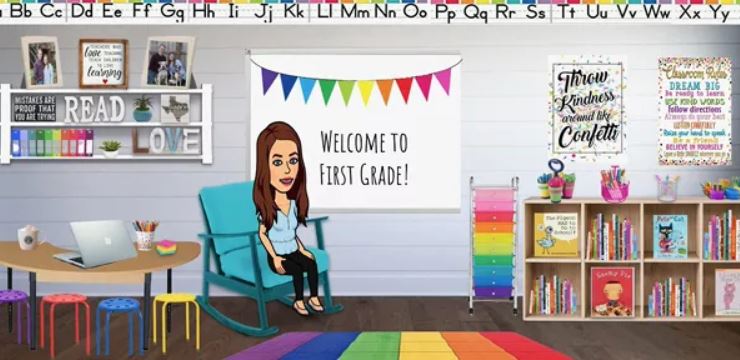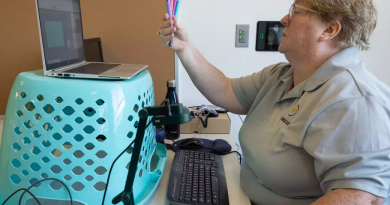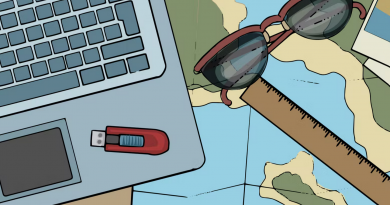Bitmoji Classrooms: Why Teachers Are Buzzing About Them
If social media posts are any indication, Bitmoji classrooms are becoming a teacher obsession. Since so many teachers are planning to “return” only to online classrooms in the fall, they’re building these colorful virtual environments for their students featuring avatar versions of themselves.
In thousands of posts on Twitter, Instagram, and Facebook, teachers are sharing the classrooms they’ve built. Using the Bitmoji app to create their avatars, and other tools like Google or Canva to build the classroom backdrop, they’re making welcoming spaces, complete with colorful rugs and posters, that can serve as a cozy home base for their classes. Students can move through the spaces virtually, clicking on a bookshelf image to get a reading assignment, for instance, or on a whiteboard to follow a link to read a science document.
It’s not hard to find teachers on social media saying they’re “hooked,” “addicted,” or “obsessed” with creating their Bitmoji classrooms. Teachers rave about how they can make a virtual space feel a little more like a homey classroom, and how their different icons and sections are handy space organizers. But their exclamation points and joyful pronouncements make it clear that teachers are just plain having fun designing them. Principals are getting in on the action, too, with a flood of posts about their virtual offices.
Jumping Aboard
The how-to’s on building these online environments are piling up: There are free templates on TeachersPayTeachers and tutorials on YouTube. WeAreTeachers recently posted a collection of Bitmoji classroom examples gathered from its Facebook groups, along with a tutorial.
The sharing on Twitter is an avalanche of positivity, with posts like this one, from Virginia teacher Esther Park, which has garnered more than 250 comments and 5,900 likes.
How to create a sense of familiarity and connection with new students remotely is something many teachers are struggling to figure out right now, and that appears to be one of the drivers behind the Bitmoji classroom craze.
With technology, teachers can try to recreate a version of one of their most cherished traditions: building a colorful, comfortable, and personal space for the new faces that cluster in front of them each fall.
Megan Syed, a 3rd-grade teacher-turned-instructional coach in Detroit, did the same thing Park did, using unscreen.com to put an animated image of herself into her Bitmoji classroom, instead of an avatar. With students having been gone so long, she said, she thought it was important to let them see right away what their teacher looks like. Since Syed will be coaching this year, she created a Bitmoji classroom how-to video so other teachers can build their own.
Not everything is hearts and roses in the Bitmoji classroom universe, though. In the past week, strains of doubt and objection started peppering the social media lovefest. Several educators said teachers are focusing too much on Bitmoji classrooms and not enough on quality instruction or healing student trauma. One complained that her school was now requiring teachers to take Bitmoji training and build the classrooms. And some people expressed concern that virtual classrooms could exclude students with disabilities.
At one point this week, a math teacher summed up the intensity level with this tweet:
The thread of comments that followed included a range of views, from those who welcomed a “war” over Bitmoji classrooms to those who saw their benefits and tried to calm everyone else down.
“I don’t think Bitmoji classrooms and quality curriculum are mutually exclusive,” one teacher tweeted. “Teachers can do both. In a time when literally everything seems to be mounted against us, we need to have each other’s backs.”
When teacher Cathryn Robbins posted that she “had zero interest” in making a Bitmoji classroom, she got so many mean-spirited comments that she hid some of them. “Who knew my lack of interest would be seen as a hot take?” she tweeted. “I love Bitmojis. Please don’t attack me Bitmoji classroom mafia.”
Robbins told EdWeek that she understood why the topic heated up on Twitter. Some teachers take great pride in their creations and might feel particularly sensitive to criticism right now because of “all the unknowns” in the upcoming school year, Robbins, who teaches middle school in Ashburn, Va., wrote in an email.
“We are all so stressed right now and already may feel attacked by politicians and parents given our general fear about returning to the classroom during this pandemic,” she wrote.
Wrong Focus?
Kelly Wickham Hurst, a former teacher who writes the popular Mocha Momma blog and co-founded the advocacy group Being Black at School, tweeted that she was “incredibly disturbed” by the Bitmoji classroom phenomenon and viewed it as a “detour” from the work that matters most: helping students heal from coronavirus-related trauma. A number of comments in response to her post echoed her concerns.
“A Bitmoji is not a substitute teacher,” one California 5th grade teacher posted in that thread. “Our students need human connection now more than ever.”
Another post that also questioned the Bitmoji craze triggered a backlash. It came from Elise Brown, the director of online professional development for the Mississippi education department. She posted that teachers should “stop fiddling around with bitmojis and all this cutesy crap and start focusing on appropriately chunking lessons and assessing online learning.” She’s since made her tweets private, so only approved followers can see them.
Brown’s tweet sparked pushback, including some from teachers who were offended by the idea that they can’t design good lessons and create a fun virtual space at the same time. One post, from Hawaii high school teacher Whitney Aragaki, highlighted the Bitmoji classroom’s power to reflect diversity.
Some posts on Twitter, such as this one, from an Ohio teacher, expressed concerns about accessibility. They dovetail with one of the big issues that have worried educators in the sudden shift to remote learning: how computer-based lessons are particularly tough for many students with disabilities who depend on assistive technology or other supports to get full access to their lessons.
Magda Chia, who oversaw accessibility in the development of the online, adaptive Smarter Balanced assessment, said teachers designing Bitmoji classrooms should make sure that the platforms they upload them to—Schoology, Google Classroom, and others—mesh well with the full range of assistive technologies that students with disabilities use, such as screen readers that convert text or images to speech.
“Many students rely on assistive technology to help them access information and be able to engage as intended,” said Chia, who now directs strategy and policy for the Understanding Language Initiative at Stanford University, which works with schools and districts on accessibility issues.
“If schools are using platforms or tools that have not been created in compliance with web content accessibility guidelines, there’s a chance those assistive technologies won’t function. If the right supports aren’t there, the risk is that students could lose access to grade-level content.”
Erica Brooks, a special education teacher in Jefferson County, Ky., who recently gave a virtual presentation on designing Bitmoji classrooms for students with disabilities, said it’s important for teachers to imagine them as places where they work with their students in real-time.
“You don’t just make this Bitmoji classroom and say, OK, here you go,” she said in an interview. “You’re in there with them, helping them find and use things in the room, and working with them on the assignments I’ve made for them there.”
By uploading a Bitmoji classroom to a platform like Google Classroom, teachers can navigate the room, and the resources in it with students in ways that are tailored to their needs, she said.
The Bitmoji Requirement
A couple of teachers complained on Twitter that their schools are requiring them to get training in making a Bitmoji classroom and to create one. One teacher tweeted about her required three-hour training with an almost audible sigh, drawing a fair amount of sympathy in response.
The thread of comments in response to her post included some teachers who loved making their Bitmoji classrooms and were glad they were getting training to help them do it and some who resented being required to take the training.
The teacher who posts as @RelevantLilly said in an interview that her principal required all teachers to participate in training on how to make Bitmoji classrooms. (The Colorado 4th grade teacher asked that her name be withheld.)
Now that she’s built her Bitmoji classroom, she said, she has softened a bit on the idea because she sees that it will be fun for her students. But she resents the training requirement.
“[W]e had all this training we had to do at the end of last year,” she said. “We lost our spring break to training, too. And now this is my summer, and you keep throwing things at us that we have to do.”
Source: https://www.edweek.org/ew/articles/2020/07/30/bitmoji-classrooms-why-teachers-are-buzzing-about.html




